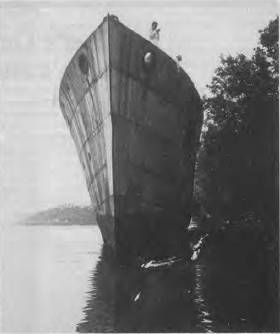- Author
- Lind, L.J.
- Subjects
- History - general
- Tags
-
- RAN Ships
- None noted.
- Publication
- December 1990 edition of the Naval Historical Review (all rights reserved)
1972 – Continued growth

During 1972 I pursued ways and means to achieve our other project, the salvaging of the bow and stern section of HMAS PARRAMATTA at Brooklyn. My efforts were directed to obtaining the support of the Parramatta City Council and on two occasions I addressed meetings of the Council. The Society was fortunate in that the Town Clerk was on our side. These efforts were to bear fruit in the near future.
From the inception of the Society we were keen to affiliate with all groups who shared our specialisation. In our first two years we affiliated with the Royal Australian Historical Society, United States Naval Institute, Antique Arms Collectors Society of Australia, World Ship Society, Nautical Association of Australia, HMAS CERBERUS Preservation Trust, New South Wales Military Historical Society, Aviation Historical Society of Australia, Albany Historical Society, Naval Records Club, The Royal Australian Navy Parents Association, Federation of Naval Ships Association, Port Jackson Maritime Museum, Belgian Naval Institute, the Naval Records Office of the Netherlands and a large number of ship’s associations. Unfortunately later Committees did not share our enthusiasm for affiliation and contact with these valuable sources of information has been lost.
The Society goes international
Towards the end of 1972 membership of the Society topped 1000. Although Australians made up the larger percentage we listed a considerable number of overseas and foreign members. These were drawn from the United States, Great Britain, Canada, New Zealand, South Africa, Germany, Belgium and the Netherlands. In this category, the United States was dominant. This arose from the large numbers of USN personnel stationed at Exmouth in Western Australia.
It may surprise some present day members to hear that our first petition to form a Chapter came from Papua New Guinea. In 1972 the RAN still maintained bases in the New Guinea area. The Papua-New Guinea Chapter was formed in Port Moresby and its membership was some fifty members. Victoria and South Australia also formed Chapters in the same year.
Support from senior naval identities
From our inception Admiral of the Fleet, The Earl Mountbatten of Burma, KG, PC, CCB, GCSI, GCIE, GCVO, DSO, FRS had shown a keen and personal interest in our Society. A number of ideas included in our constitution stemmed from suggestions he had put forward. It was for this reason our Annual General Meeting conferred on him Honorary Life Membership. The same honour was conferred on Commander G. Hermon Gill, the RAN’s Official Historian in World War 2 and author of both volumes of the Official History.
The name of His Royal Highness, Prince Philip, was also put forward at this meeting but convention does not permit the conferring of honours on Royalty. However, Prince Philip’s interest in the Society has not flagged as his writing of the preface to ‘HMAS HOBART’ and his unveiling of the HMAS PARRAMATTA Memorial at Garden Island demonstrates.
It is interesting to note that eight Vice Patrons were elected to the Society in 1972. They were: Admiral Sir Victor Smith, KBE, CB, DSC; Vice Admiral Sir Henry Burrell, KBE, CB; Vice Admiral Sir Richard Peek, KBE, CB, DSC; Rear Admiral G.J.B. Crabb, CBE, DSC; Rear Admiral H.D. Stevenson, CBE; Rear Admiral B.W. Mussared, CBE; Rear Admiral W.D.H. Graham, CBE and Mr Samuel Landau, CBE, MA.
Seven new Committeemen were elected at the Annual General Meeting: Lieutenant Commander W.N. Swan, RAN, Lieutenant R. Torrington, RANR, William Farrell, Vaughan Evans, Roy Scrivener and Charles Gould. Mr Daniel Good was appointed Auditor.
The new members brought a broad spectrum of experience and interest to the Committee. Lieutenant Commander Bill Swan had served in Naval Intelligence, Lieutenant Reg Torrington in escort carriers, Bill Farrell was a corvette man and Roy Scrivener a cruiser man. Vaughan Evans was an expert on naval lore and Charles Gould was a magistrate.
Group Captain Keith Isaacs, A.F.C. RAAF, the RAAF historian and author, joined our ranks during this year and brought with him a wealth of knowledge on the genesis of RAN aviation. The first of a four part treatise on the Royal Australian Navy Fleet Air Arm commenced in ‘Naval Historical Review’ in December of that year.
An active start to 1973
Our first address for 1973 was ‘The American Civil War’ presented by one of the most colourful figures to grace our rostrum, Mr Leonard Traynor. This address was notable in that it highlighted the great number of advances made in naval warfare in that conflict. To mention just a few it introduced the first successful submarine, the dreadnought, anaesthesia, armour piercing projectiles and the first dehydrated rations. Leonard Traynor was an expert on his subject and conducted lecture tours in the United States on this subject.




